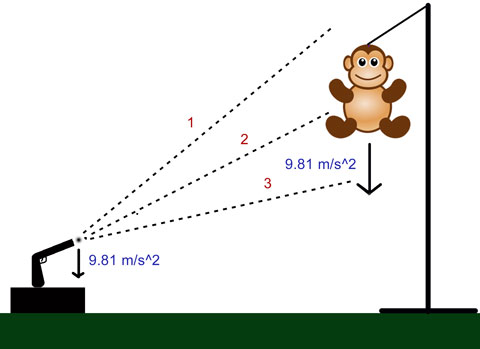The Monkey and the Hunter
June 20, 2013
Thought experiments abound in the world of physics, often revealing some of the most confusing aspects of quantum mechanics, relativity, and thermodynamics. But the “Monkey and the Hunter” thought experiment tackles a relatively well-understood topic: gravity.
Imagine a hunter in the jungle who has just spotted a monkey grasping a tree branch above him. To avoid more troubling moral questions, let’s assume that the hunter must capture the monkey to treat it for a disease before releasing it back into the wild.
The hunter also knows that the monkey will reflexively drop from the branch immediately after the hunter pulls the trigger. Immediately after the bullet exits the barrel, the monkey will begin his free fall toward the ground.
However, the hunter doesn't know exactly how fast the tranquilizer bullet will travel after leaving the gun — he just knows it'll move fast.
With all of this in mind, where should the hunter aim? Where would you aim? Three choices arise:
1. Aim above the monkey
2. Aim directly at the monkey
3. Aim below the monkey

Where should the hunter aim? Above, below or straight on? Note: No animals were harmed during the development of this thought experiment or this Photoshopped image.
Intuitively, you might think that the hunter needs to aim below the monkey due to how fast the bullet moves. If he shoots at or above the monkey, won’t the bullet whiz over its head as the monkey falls toward the ground?
But that's wrong. The correct answer is 2: Aim directly at the monkey.
Once the bullet exits the gun, there’s only one force acting on it with any significance: gravity (and some negligible air resistance in this case). Likewise, only gravity will act upon the monkey after he loosens his grasp.
The constant acceleration due to gravity affects both the monkey and the tranquilizer in the same way. Consequently, the bullet will fall a little bit below the initial aim trajectory (the #2 line in the image). By the time the bullet travels the horizontal distance to reach the branch, the monkey will have fallen the same amount as the bullet in the vertical direction, leading to impact.
The speed of the bullet doesn’t even matter in this case. A faster bullet will hit the monkey at a higher height while a slower bullet will simply meet the monkey closer to the ground. Because gravity imparts the same acceleration on both objects, their vertical positions will be inextricably linked if the hunter aims directly at the monkey.
You can see a live demonstration of this experiment — with a tennis ball and an inanimate target — in the video below.














